Secession Golf Club, SC
by Walter S. Morris, Jr.
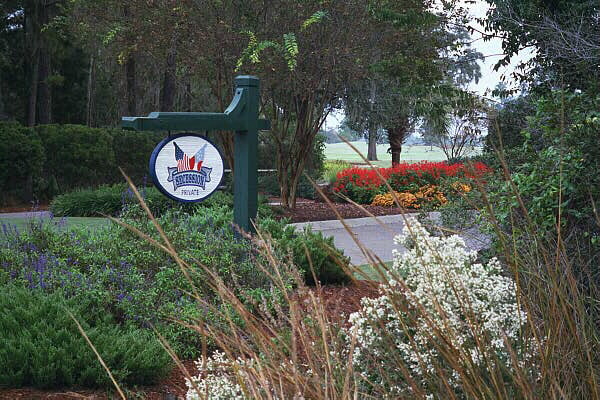
Created by Bruce Devlin, Secession plays over 7000 yards from its most extreme tees and features a links style design that winds its way through the wetlands of the Low Country of South Carolina. The name Secession was borrowed from a time long removed, for it was in the small town of Beaufort that the original Articles of Secession from the Union were drafted in 1860. Currently there are 750 members, with a waiting list. Secession requires walking with Caddies ( no golf carts ). The course is a wonderful walking experience, with the majority of the holes being relatively flat. The distance between greens and the next tee is short and in my view the perfect distance for a great walking course. As with most true golf clubs no houses will be built on or around the course. Dormitory style rooms in the club house and a cottage community across the street, house members and their guest.
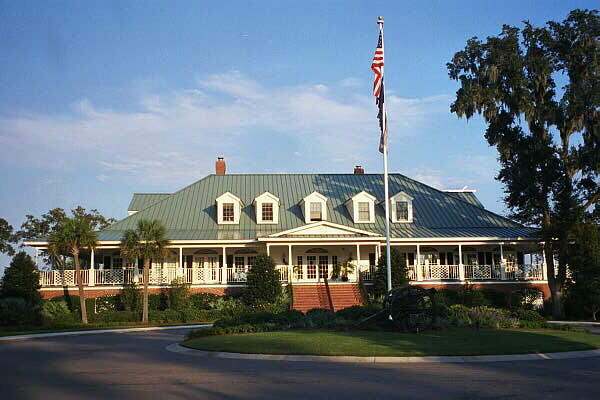
The clubhouse exudes southern charm with its wrap-around porch.
Secession is a true Golfing Experience. Each of the holes described below are named for a battle which occurred during the war between the states. The brief hole by hole description below is seen through the eyes of a 12 handicapper with yardages being given from the Lee Tees ( 6685 Yards ). The tees are named for Generals from the War between the States. The Grant Tees are the back tees at 7035 yards; the Lee Tees are the middle tees at 6685 yards; the Sherman Tees are the up tees at 6167 yards, and the Jackson Tees are the women’s tees at 5512 yards.
Hole #1 ( Fort Sumter ) The opening hole is the first indication that this is a special place and the golfer is in for a first class golfing experience. The first visual impression of the this hole is a vast low country marsh and a long carry for the first drive of the round. In reality, depending on the tees one chooses to play and the amount of marsh land one chooses to traverse, the drive ranges from 150 to 250 yards of carry. Following is a short iron to a small flat green surrounded by marsh on three sides and a small pot bunker in the front right. While a birdie is an excellent possibility on the 345 yard opening hole, a par is always a very good beginning to a most exciting round of pure golf.
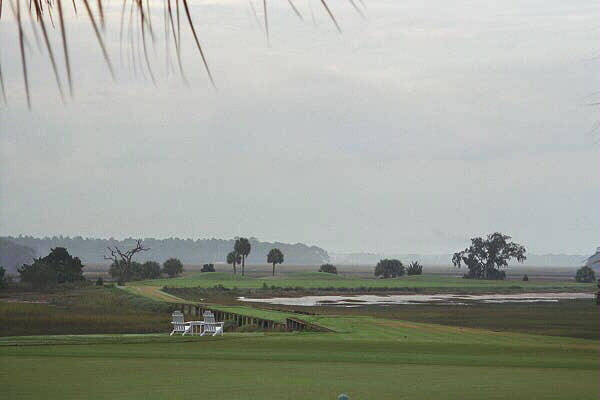
The day's first tee ball is a risk-reward diagonal carry over the marsh.
Hole #2 ( Bull Run ) The second hole is a straight forward par 3 (147 yards), which is slightly up hill, with a small sod faced bunker on the left and a moderate sized green which slopes from back to front. If the wind is up from the left or the right, this hole can become 1 to 2 strokes harder. A par here will keep the adrenaline flowing.
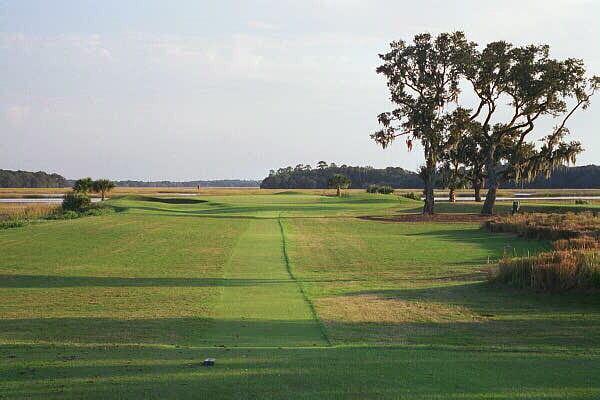
The view from the 2nd tee.
Hole #3 ( Port Royal ) This No. 1 handicap hole requires a long , well placed and accurate drive. The second shot must carry marsh which is approximately 25 yards from the large green. From the Lee Tees, this 410 yd hole is made even more difficult or easier depending if it is played into the wind or down wind. Because the green is large, a three putt is always a potential possibility. A par here usually is a winner in match play.
Hole #4 ( Shiloh ) A forced carry of 175 to 180 yards over marsh to a landing area, 40 yards wide, with a large, hidden bunker on the left and marsh on the right, makes the drive a critical beginning to this short ( 356 yards ) par four. A small kidney shaped green with a sod faced bunker in the internal curve and marsh on the right and to the rear of the green demand an accurate short iron , if a birdie is to be the prize. Par will usually get a half in match play.
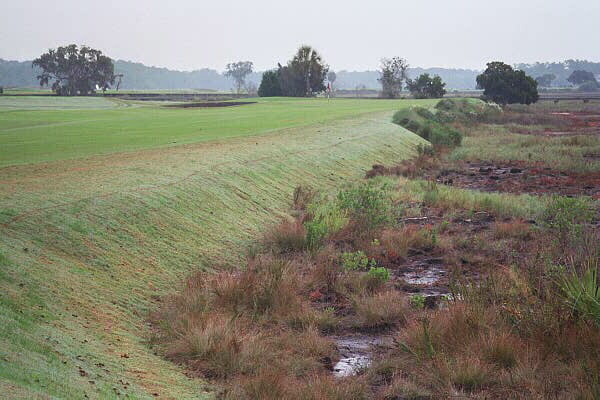
With the bunker left and the marsh right, the kidney shaped 4th green requires one of the day's most accurate approach shots.
Hole #5 ( 7 Days’ Retreat ) The first par five ( 500 yards ) can be reached in two by a long hitter, but is a very good three shot hole for all middle to high handicap players. The second shot requires a forced carry of 150 to 175 yards which will make the third shot an eight iron to sand wedge. Do not be above the hole on this green which has a pronounced back to front slant. Three putts are not uncommon on this large green. While birdies are the reward for the long hitter, a par will keep a good round going.
Hole #6 ( Harper’s Ferry ) Once again 150 to 180 yards carry over marsh to a large landing area is the beginning for this short ( 347 yards ) par four. A good tee shot leaves a mid to short iron shot to this wide but shallow green. Do not be long here or you may find a treacherous POT bunker in the rear of the green. Make sure your approach shot is on the same side of the green where the hole is placed or a three putt is very likely. As always a par here is always a good score.
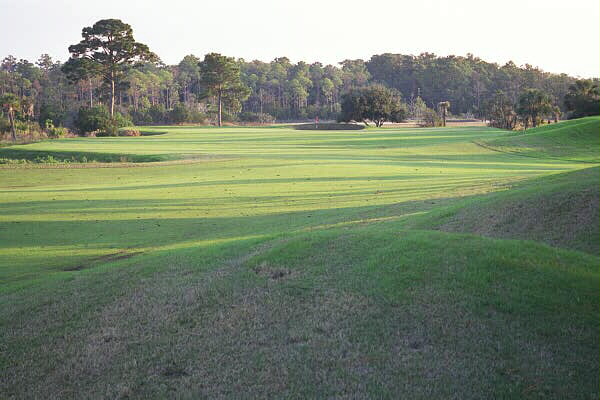
The widest green on the course requires a precise approach to the 6th.
Hole #7 ( Antietam ) With water on the entire right side of this medium length ( 382 yards ) par four an accurate drive will make the approach to the green available with a mid iron. The large multi-level green has a narrowed approach with trees on the left side and water on the right side. Accuracy and length off the tee will make for an easy par on this good par four. Beware of alligators sunning on the bank along the water on the right side.
Hole #8 ( Fredericksburg ) This scenic Par 3 ( 181 yards ) can be a real tester, especially if the wind is in your face. To reach the large green requires a mid to long iron over water the entire length of the hole. There is a bailout area to the left of the green, but there are two large mounds which can play tricks with a ball hit to far to the left. Any weak shot to the right is usually water bound, with a bogey or worse a possibility. Par here is a good number on this excellent hole.

The safe play on the 8th is to the left as short or right spells trouble.
Hole #9 ( Chancellorsville ) Wind plays a major factor on this long par 5 ( 612 yards ). Down wind this hole is at best a three shooter. With the wind in your face four very good shots maybe required to get home. While this hole is fairly straight, there are two POT bunkers about 150 yards from the green, and two cigar style mounds which guard the entrance on both the left and right sides. The entry between the mounds is approximately 15 – 20 yards to this large flat green. Par at this hole is a first class finish to the first nine holes.
Hole #10 ( Vicksburg ) The back nine opens with another par 5 ( 536 yards ) which plays parallel to her sister hole #9. A drive between woods which are approximately 40 yards wide, sets up a second shot towards bunkers on the left side of the fairway as a target or a longer shot over a wilderness area which leaves a shorter approach to a moderately large, flat green. The green is protected on the left by a small Oak tree. A good approach and a one putt can start the back side with a well earned birdie.
Hole #11 ( Gettysburg ) The par four #11 is the beginning of a series of three par fours that will require all the skills a golfer can muster. A drive on this 444 yards hole must be long and straight or slightly left to avoid the large pond on the right side. When the wind is in your face this pond seems like a magnet for a ball with a slice or a fade. A well placed and safe drive sets up a medium to long iron to a green which is 60 yards deep and 25 yards wide. The green runs away from the golfer causing a shot hit to firm to run to the back or through the green. Two putts here will reward the player with a well deserved par.
Hole #12 ( Chickamauga ) If #11 was played down wind, #12 ( 433 yards ) will play into the wind or visa versa. The drive is played to a wide-open, generous fairway. A mid to long iron must be accurate to avoid a pond and bunkers on the left and woods on the right side. A well placed second shot will favor the right side since a large mound will move the ball toward the center of the green. This two tiered green is deeper than it is wide. Again two putts should reward the player with par.
Hole #13 ( Missionary Ridge ) This last of the three long par fours ( 426 yards ) has a generous landing area for a well placed drive. Again depending on the drive, a mid to long iron or utility wood is required to carry a marsh area to reach this slightly uphill green. The green is generous in size and sloped back to front. For the faint of heart, an ample bail-out area is short and right, which will avoid two new POT bunkers on the left side of the green. Once again a two putt par will allow any player who has played #11, #12, and #13 even par, a real sense of satisfaction and pleasure for having conquered three of Secession’s Best.
Hole #14 ( Wilderness ) When I have a first-time guest at Secession, I tell them ‘ I feel this par four ( 370 yards ) is my signature hole here at Secession’. Not only is it a relief from the previous three ‘long’ par fours, it is visually one of the most striking holes at Secession. A long iron, three wood or driver may be used for the drive which should be aimed at the flagpole at the clubhouse and placed 200 to 230 yards from the tee. Too far right and you may be on the 11th green and too far left will place a hooked drive in the marsh. A walk of about 40 yards off the tee and the entire panorama of the leafless skeleton of a dead tree, the marsh, the green, the sandbag wall, and two large Oaks all come into view. A short to mid iron is required to reach this kidney shaped green. The player must be careful when challenging a left rear pin placement as the green is very shallow in this area with marsh in front and the 15th tee in the rear. A front right pin offers the best opportunity for a birdie, however beware of the large Oak guarding the front right side of the green. Par at this ‘ my favorite ‘ hole is an excellent score.
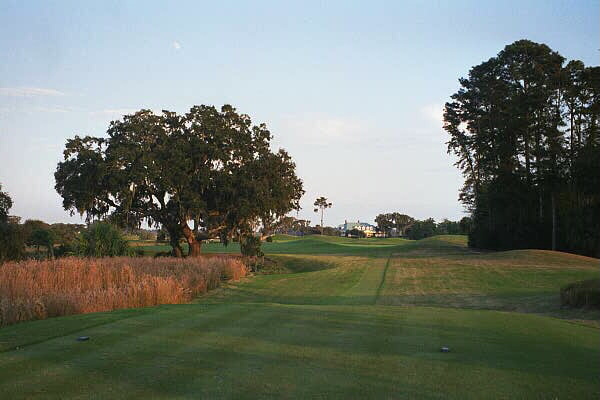
A draw off the distant clubhouse makes for an ideal start to the 14th hole.
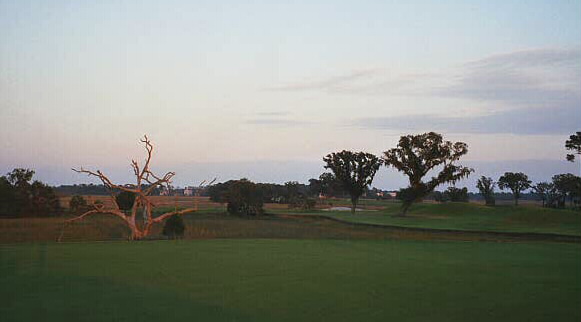
The approach is a full carry over the marsh and the 14th green is framed by the two oak trees on the right.
Hole #15 ( Cold Harbour ) As with all the holes at Secession, wind on this medium length par 3 ( 172 yards ) can make a one to two iron difference. A mid iron for the low handicapper should find the middle of this large ample green. Several small undulations and a left to right slope will challenge the one putt, but should allow a routine tap in for a par.
Hole #16 ( Hatcher’s Run ) This hole is the shortest of the par fives ( 475 yards ). It can be reached by the low handicapper in two with a well placed drive and a long iron or fairway metal. Trees on the right and several new POT bunkers keep the player from trying to cut the corner as in the past. The middle to higher handicap player will play a second shot to the left of two fairway bunkers, which sets up a short iron to the mid sized green. All players should avoid a large, very high sod walled bunker on the right side of the green. Players have disappeared in this bunker, and only the most skilled players can hit a wedge with enough loft to clear the sod wall. Subtle contours make an eagle putt difficult, but a birdie tap-in is a real possibility and a two putt par a satisfying score on this par five.
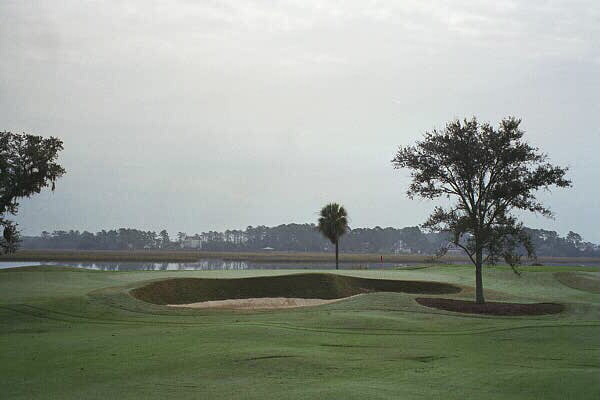
Though a reachable par five, the 16th green is heavily defended.
Hole #17 ( Mobile Bay ) One of the most controversial holes is this short par 3 ( 124 yards ). The green is approximately 20 yards by 25 yards and is an island with a three feet to five feet bulwark surrounding it. Wind will play a major factor with the short to mid iron. The entire green is marked as a lateral hazard if your shot carries the green into the marsh over the green. If the player misses the green, left or right, at low tide he may choose to play a sand wedge shot and try for his one putt par. A tee shot that finds the green is an excellent opportunity for a one putt birdie or a tap-in par. Either way this short par 3 is a unique and fun hole to play.
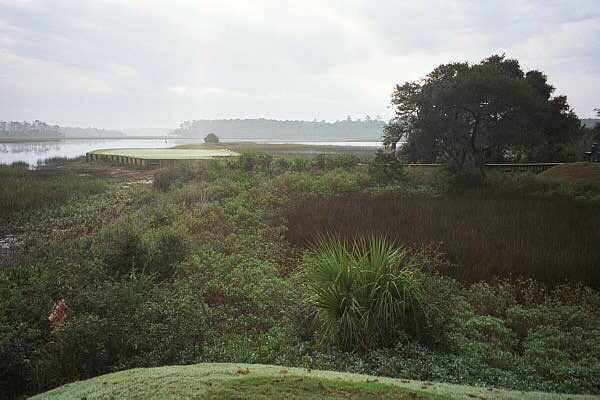
The setting for the island green 17th is much more natural than the more famous 17th at TPC Sawgrass.
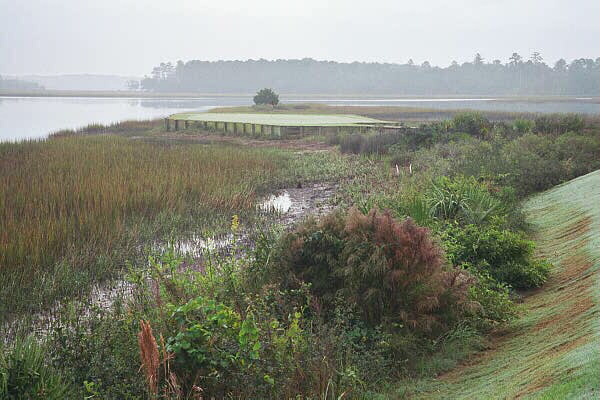
Secession's windy locale makes the 17th an even tougher target.
Hole #18 ( Appomattox ) The 18th is an excellent finishing hole for an outstanding golf club. This long par 4 (425 yards ) requires a 225 to 240 yard carry over marsh which allows a short to mid iron to get home. The average player will play the drive to the right side of the marsh to an ample landing area, being careful to avoid a large bunker which divided the 18th fairway from the 16th fairway. This longer route will require a long iron or fairway metal to a large green protected on the left and right sides by several POT bunkers. The green slopes from back to front and continues from the back to become a part of the practice green. Par here is an excellent finish to a wonderful day of golf here at Secession.
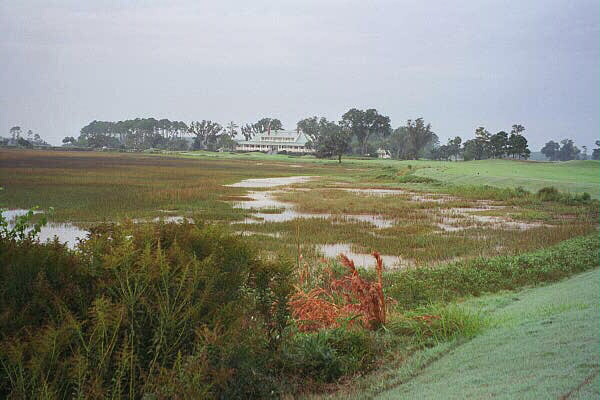
The 18th doglegs left along the marsh as it heads back toward the clubhouse.

A view back down the 18th.
To complete that wonderful day of golf, one only needs to walk a few steps to the gracious and spacious porch surrounding the club house, with wicker cushioned chairs and rocking chairs, for a relaxing libation and final repast with friends. Thanks to Director of Golf, Michael Harmon; Greens Superintendent, Chris Newnham; Caddiemaster , Greg Crum, and General Manager, Marc Lucas and their outstanding staffs, the Secession experience is one to remember.
Each time I have a guest for a few days of play, they all come away singing the praises of Secession and all the people who make this such a special place. If you have an opportunity to make a trip to Beaufort, S.C. for a round or two, make sure you clear the calendar and enjoy a special treat. I hope you have long, straight drives, accurate irons and few putts.
Good Golfing. WSM
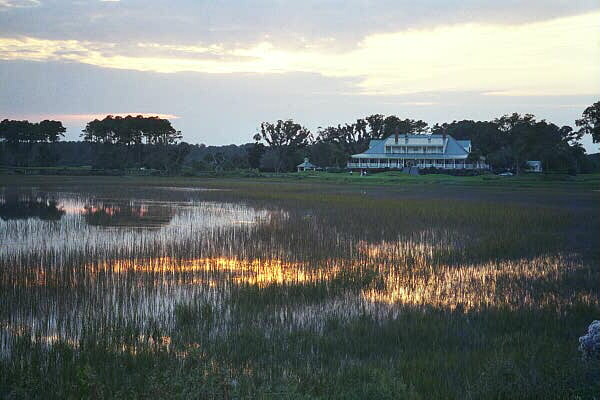
Secession enjoys a solitude rarely found in courses built after World War II.
The End







